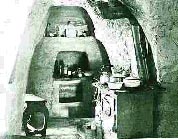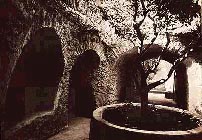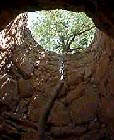
 |
 |
 |
 |
 |
 |
 |
email: roadarch@outlook.com |
 |
| Forestiere's Underground Gardens |
(hit "refresh" to get the most recent version of this page; click on photos for larger images)
 |
 |
 |
|
Baldasare Forestiere came to the U.S. in 1901 at the age of 22 and found work digging the subway in Boston and then a tunnel connecting NYC and NJ. In 1908, he went west and arrived in Fresno where he purchased 70 acres of land at a great price without seeing it first. He thought he was buying farm land, but it turned out the land only had an inch or two of topsoil over hardpan – basically rock-like soil which was useless for growing things. He began work as a contractor, in charge of planting grape fields for surrounding farms. To beat the heat, he started to digging his own underground tunnel and created a 4 room apartment. He found fertile soil below the hardpan and, mixing it with soil from ancient lakebeds 75 miles away, started building a garden.
He used the hardpan as a roof, cutting circular holes in it for ventilation and creating light and rain for the garden. By the time he died in 1946 (age of 67), after 38 years of building alone, he had constructed more than 90 underground rooms and 10 acres of patios, courts, archways and grottoes. Engineers marvel at how this small man (5' 4"), who never learned to read or write, built this place with only a pick, shovel and wheelbarrow. Paths meander through nearly 7 acres of underground rooms and gardens 10-25 feet below the surface. Citrus trees, some grafted to grow up to 7 varieties of fruit, grow from pots carved in the underground chambers through holes in the hardpan roof. Above ground you can pick fruit from the treetops. The son of a fruit rancher, he knew about gardening and the grafting of fruit trees. Despite hundreds of varieties of plants, animals and insects are rarely seen. There are also elaborate drainage systems. As Forestiere said, "to make something with lots of money that is easy – but to make something out of nothing… now that is something." He was also driven by unrequited love as was Ed Leeskalnin (Coral Castle). After the initial building of the underground house, Forestiere went back to Italy to ask his childhood sweetheart to come to America but she refused. He then went back to building with a vengeance. By 1923, when he had completed 50 rooms and an 800’ long underground roadway for cars, Forestiere had to mortgage the property to keep up his work. But in 1931, the mortgagees foreclosed and he was forced to open his caves to the public to raise funds. At the time of his death he was working on a ballroom and an underground lake. He had excavated and floored the 3500 square foot ballroom with composite stone and covered it with a large wooden roof. The lake is a small one with a circular room only 10’ in diameter with a hole in the roof to let in light and another hole about 4’ wide in the middle of the floor. Below is a small bell-shaped chamber with ledges on which to sit. The idea was to cover the hole in the roof with a sheet of glass then fill the room above with water to make a shallow pond. You could then sit in the chamber below and watch fish above (like an aquarium in the ceiling. Some people speculate that he was building an underground resort (evidence of a possible restaurant and parking lot), others think maybe a bomb shelter. The current owners of the house, Forestiere’s nephew and wife, haven’t got the money to finish the construction. Although the remaining 4˝ acre site is an historical landmark, a lawsuit has dragged on for years keeping the Gardens closed to visitors and depriving the Forestieres of income. They have been offered nearly $2 million, but they refuse to sell. Parts of the garden have been destroyed because of highway expansion, as well as erosion and neglect. The family still talks optimistically of completing about 15 rooms and reopening the place to tourists. UPDATE: The site has been reopened for tours and used for weddings, business meetings, parties and small concerts (contact the Gardens directly for info). For more, see these websites: 1, 2, 3, and 4. |
| Special Places Main Page |
| RoadsideArchitecture.com |
Copyright. All photos at this website are copyrighted and may only be used with my consent. This includes posting them at Facebook, Pinterest, blogs, other websites, personal use, etc. Tips & Updates. If you have suggestions about places that I haven't covered, historical info, or updates about places/things that have been remodeled or removed, I'd love to hear from you: roadarch@outlook.com. |